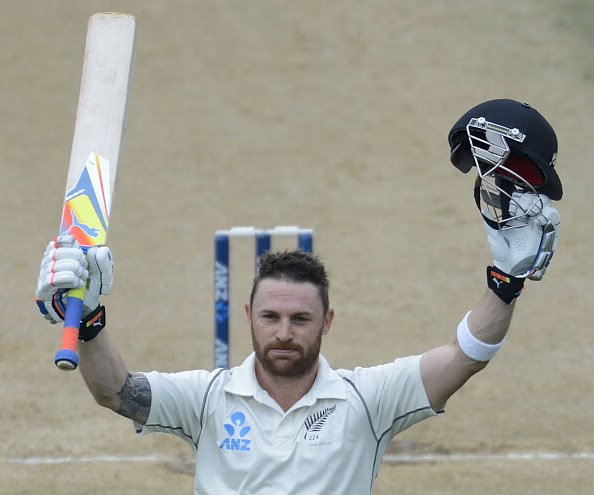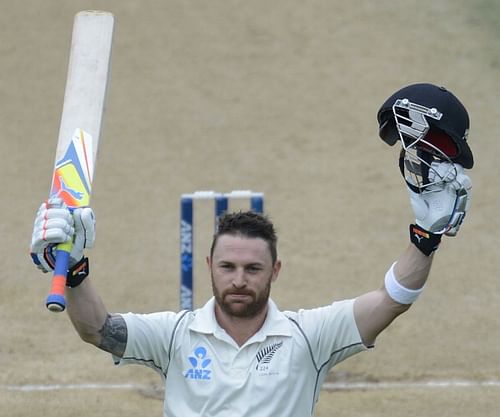
Impact of T20 on Test and ODI cricket
A T20 match which lasts no longer than 4 hours has surely huge impact on Test and ODI Cricket.
Captain of New Zealand Brendon McCullum celebrates 300 runs during day 5 of the 2nd International Test cricket match between New Zealand and India in Wellington at the Basin Reserve on February 18, 2014.
As we are in the middle of a T20 World Cup, we look back at how this fast-paced, ever growing format has impacted the other two superior formats of the game. The purists always feared that this format would take over Test and ODI cricket, but that hasn’t happened, so far. However, Judging by some of the scores we are seeing in One-Day Internationals, one does get a feel that the T20 effect has already crept in.
Also, we are getting to see some of its effects in Test Cricket. Didn’t Chris Gayle smash the very first ball of a Test match for a six around 18 months ago? How many times have we seen that before? And how many Test matches in recent memory were boring and ended in dull draws? Not many.
Impact on ODI cricket
T20’s impact on the 50-over format goes beyond stats. Yes, we get to see a lot of 300-plus scores these days and sometimes even 350-plus scores. The real impact, though, started to show up when teams became increasingly confident of chasing down any total. Batsmen do realize that if they can accumulate wickets in the first 30 overs, then they can virtually chase down any amount of runs in the last 15 to 20 overs.
There is no doubt that the new fielding restriction rules have contributed a lot to this, but, at the same time, one cannot deny that teams prefer chasing these days after successfully chasing down totals in the 20-over format.
Teams do understand that if given a good batting surface, the totals will soar above 320 especially with the new rules in place. Since you have to bat for 50 overs, one may not be sure about the winning total. Over the years, the par score has seen a rise in this format. It was 250 in the late 90s as compared to 220 in the early 90s. Post 2000, teams considered 275 as the par score, but, over the last few years, there is no doubt that teams are unsure about it because of the batsmen chasing down huge scores.
Is there a safe score now in the 50-over format?
The world record run-chase was probably the first instance which kick-started this trend. Nobody saw that coming after Australia had posted 434. And then prior to the 2007 World Cup, we saw New Zealand chase down 336 and 346 against Australia in consecutive games.
India fell agonizingly short of 3 runs while chasing 350 against Australia (again) in 2009, and Sri Lanka fell short by the same margin against India while chasing 415 in the same year. Virat Kohli’s blitz to help India chase 320 in just 37 overs is something that no fan will ever forget.
And remember, the above mentioned instances happened when five fielders were allowed outside the circle. Also, it’s worth mentioning that One-Day cricket saw three double hundreds post the ‘T20 era’, and it looks like there are a few more to come in the near future.
Over the last few months, we saw India chase down 350 twice against Australia and tie a game against New Zealand where they scored 314. In that tied game, India actually needed 131 runs in less than 15 overs having already lost 6 wickets.
No more do fans lose hope when the opposition posts a 300-plus total. Go back by ten years, and you will realize that whenever a team posted a 300-plus total, it was invariably decided that they would go on and win. These days, though, chasing teams take the fight to the opposition till the end, which is exciting to watch.
Impact on Test Cricket
Wasn’t Test cricket supposed to be taking a backseat in the minds of fans with T20 taking over? There is no doubt that the T20 fan base is growing each day, but the ultimate format is still on top and continues to draw the respect of fans and players all over the globe.
Things may change in the future, but, in order to make sure Test cricket continues to attract the future generation, the format needs to be a bit fast-paced and more importantly result-oriented. If Test Cricket keeps churning out dull draws, then the next generation would never be interested in the format.
So, is it time to press the panic button? Results over the last few years say NO. T20 has brought in a sense of fearlessness in the minds of batsmen, and we are seeing higher run rates and in return results, rather than dull draws.
